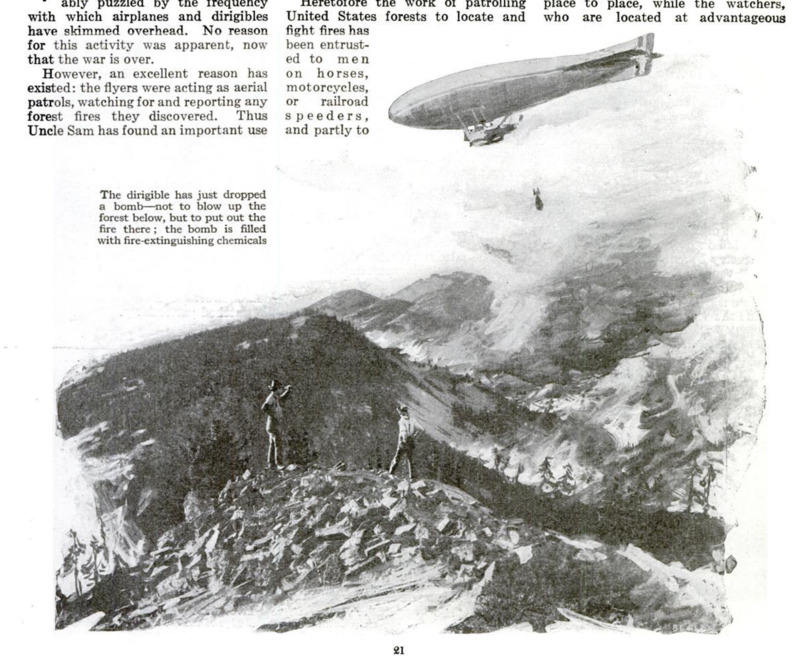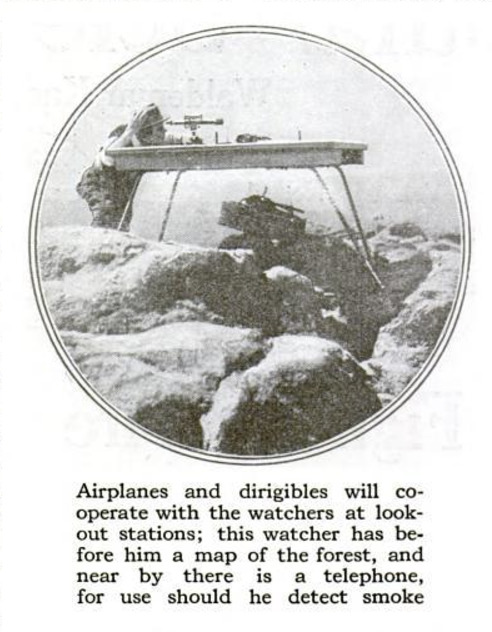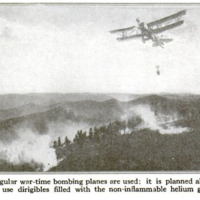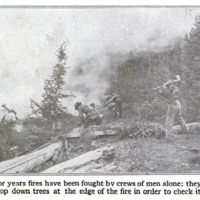-
Titolo
-
Fighting Fire from the Sky. The forest ranger becomes an aviator
-
Article Title and/or Image Caption
-
Fighting Fire from the Sky. The forest ranger becomes an aviator
-
extracted text
-
VISITORS to our national parks
this summer have been consider-
ably puzzled by the frequency
with which airplanes and_dirigibles
have skimmed overhead. No reason
for this activity was apparent, now
that the war is over.
However, an excellent reason has
existed: the flyers were acting as aerial
patrols, watching for and reporting any
forest fires they discovered. Thus
Uncle Sam has found an important use
for his aces of the air right here at
home.
Heretofore the work of patrolling
United States forests to locate and
hght fires has
been entrust-
ed to men
on horses,
motoreyeles,
or railroad
speeders,
and partly to
watchers stationed at lookout
points. The former travel about from
place to place, while the watchers,
who are located at advantageous
|
pots, usually on the top of some high
mountain-peak, never leave ther post,
but romain constantly on the lookout |
for fre.
“The observers at lookout stations
aro provided with all the latest scion.
tlic instruments for locating distant
objects, and vith carefully prepared
naps showing the nameso all canyons, |
streams, roads, Tanger stations, and
tho ike:
How the Watchers Do Their Work
“These men hive powerful field-glasses,
and a telephone leads to the nearest
Tanger station and to tho foreat super.
Vitors ofc. If a firo n discovered, |
the watcher immediately telephones
to headquarters, giving the location of |
the fire as it is projected on the map
of the station; u crew of men in des
patched to fight it.
“The offciency of this system has |
been increased from year to. year,
until now it In ar up-to-date and ut |
successful, in its own fold, 43 that of
municipal fire department, In fact,
tho same cusentil factors for success
are employed in the forest work that
are universally recognized aa neces.
ary for fighting fires in cities: namely,
first, datoction of the blaze before it
hin gained headway; and, second,
prompt attention.
According to reports compiled by
tho Forest. Service, there wero in the
United States an’ sverage of 28,735
fires a year. between. 1015 and 1917.
The ground covered by these fires
amounted to 8,052,945 acres. Tho esti
mated damage was 39,875,000.
A roport. covering the’ period be |
tween 1913 and 1917 showed a yearly |
average of 6,184 forest fires, with
56,663 acres burned and damage to
the extent of $300,000.
Last fal it occurred to oficial of |
the Forestry Bureau to supplement the.
ork of the regular forest rangers by
the addition of air scouts, and a fo
experimental flights were made to de-
termina the value of the airplane and.
dirigible in this connection. These
experiments proved so satisfactory
that Secretary Baker issued an order
directing the Air Service to cooperate
with the Forest Service in the work of
forest fire patrol,
and, beginning
with the first of
June, the plan was
regularly put into
operation.
Air scouts and
bombers who saw
service in the
Great War were
set to work in
the forests; and
dirigibles — filled
with the new
non - inflammable
helium gas in-
stead of dangerous
hydrogen—will
also be used in
patrolling the
forests for fire.
Reports receiv-
ed by the Forestry
‘Bureau show that
the airmen experience no difficulty in
detecting fires in heavy timber at an
elevation of ten thousand feet and
even more. From this.it will at once
be evident what an advantage the air
scout enjoys over the watcher in a
lookout station. Even when these
stations are located on mountain-tops,
the range of the observer is more or
less limited by reason of the character
of the country cut by deep canyons
and broken by mountain-ridges. Fur-
thermore, the area of country that he
can see at any time is always the same,
whereas the airplane scout, flying
swiftly at a much higher altitude, is
enabled to cover a wide and ever-
changing stretch of country within the
space of a few minutes.
The aerial observer has still another
advantage, of the greatest importance,
over the watcher in the lookout station.
The latter, when he has discovered a
fire, can do nothing more than tele-
phone its location to the nearest fire
guard; he depends upon others to go
to the scene and combat it. On the
other hand, the air scout, when he has
located a blaze, can send in the alarm,
and then, swoop-
ing down over the
spot, drop on it
bombs charged
with suitable
chemicals for ex-
tinguishing fires.
By this means he
is frequently en-
abled to put out
the fire unaided,
or to check its
growth until the
regular fire-fight-
ers have time to
reach the place
before it has gain-
ed any consider-
able headway. In
this connection, a
plan that is soon
to be tried out
proposes trans-
porting fire-fight-
ers in dirigibles from which ladders
can be lowered to the ground.
Warnings Flashed by Wireless
The observer in a lookout station
locates fires by means of triangulation,
reports being telephoned from separate
observation points. The air scout
locates them by coordinates in the
same way that gun-fire is directed to
a particular spot or object—that is,
by means of squares drawn on dupli-
cate maps, one being in the possession
of each airplane observer and another
in the office of the forest supervisor.
The tentative plan is to equip the
patrolling airplanes with wireless sets,
with which the pilots may flash the
first signals of fire. Roads and path-
ways where a carelessly thrown cigar-
ette may be the cause of thousands of
dollars’ worth of damage will, of course,
be watched particularly.
-
Autore secondario
-
Robert H. Moulton (writer)
-
Lingua
-
eng
-
Data di rilascio
-
1919-10
-
pagine
-
21-22
-
Diritti
-
Public domain (Google digitized)
-
Archived by
-
Davide Donà
-
Alberto Bordignon (Supervisor)







